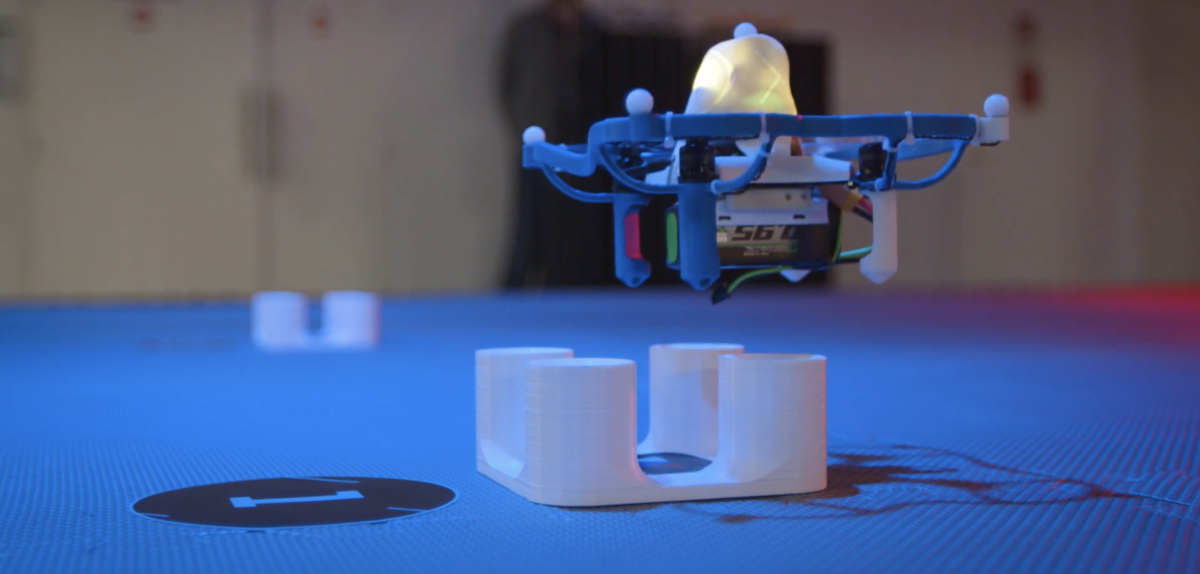You are here
The buzz of propellers, brilliant flashing lights, and vibrating controllers – gamers will soon be able to compete in a new kind of arena. Even as they disrupted the market, recreational drones still required users to undergo hours of training. Robotics researchers working in partnership with Drone Interactive have developed an app both fun and impressive, in a gaming center in the suburbs of Lyon. The Arcadrone platform creates a game where four players can compete simultaneously, easily piloting drones even if they’ve never flown before!
In order to make a game like this accessible to such a large audience, Drone Interactive had to overcome a number of technical challenges along the way.
VINCENT RIGAUX – FOUNDER OF DRONE INTERATIVE
We have four drones in a 25 square meter arena that is just 2.5m high. It’s relatively small. If we were to put four manual drones in here with pilots who have never flown drones before, without a doubt, after 30 seconds the drones would end in a heap on the floor.
It was a serious technical challenge to come up with something more readily accessible. From six years old and up, people can play with this system. No collision is possible between the drones, however you can still push the other drones around, which is a fun element of the game. They can’t escape the arena as they’ll run into their own virtual barriers. Imagine the drones surrounded by balls of energy which prevent contact and the resulting crashes.
The arena is equipped with multiple motion-capture cameras that record the real-time location of each machine. Controller in hand, the player manipulates the drone from a distance. But tomorrow, they could be plunged into an entirely different universe. Arcadrone is developing games using augmented reality. The player, equipped with special glasses, can see 3D game elements projected into their field of vision and that interact directly with the drones in the arena. In order to make all this possible, speed, stability, and obstacle avoidance all rely on powerful algorithms. Drone Interactive has also collaborated with specialists in machine-human interaction.
For the last 15 years, research teams at the GIPSA lab in the French Alps, have been working on drone technology. The scientific problems include flight safety, drone control, obstacle avoidance, and even the vulnerabilities to hacking. They’re creating algorithms for this alongside industrial partners. In order to efficiently prove their mathematical tools, the scientists are testing them against benchmarks within virtual simulations.
MATHIEU MUSCHINOWSKI
Our main interest is to be able to run a large number of tests and gather statistics on the algorithms we’re using. It’s something we couldn’t do outside, because we don’t have a massive fleet of drones to expend.
Our secondary interest is in obtaining a more objective tool to analyze the results. That is to say that when we fly outside or in certain conditions, we can’t compare what we did to what people would do in South America for example. So the second advantage of the benchmark is to have something extremely repeatable and comparable.
After having validated their algorithms in a virtual universe, the researchers put them to the test in the real world within this indoor obstacle course. These drones, made in this same lab, need to follow a pre-set flight plan and autonomously avoid obstacles. It’s a more cost-effective way of testing the algorithms before running further tests outdoors.
As the world prepares for drones to deliver packages, secure sensitive sites, or even transport organs, researchers are rushing to explore all scientific problems linked to these autonomous flying machines.
NICOLAS MARCHAND – ROBOTOCIST
One of the main problems with drones is autonomy, which is relatively limited due to battery usage. This limitation is one that our research will help lift by working not only on the batteries, but equally by using hybrid drones which could improve flight times and load-bearing capacity. Even as we work towards applications like delivery, there’s already a lot of talk, which means we have to be mindful of how the public will react to this technology. At the moment we’ve mastered getting a drone to take off from one point and land at another completely autonomously. Unfortunately, we can’t guarantee that it will avoid obstacles, nor can we be sure that if there’s a problem en route, it will be able to find a safe solution given its environment.
As we wait to see drones evolve to fly autonomously through our cities, scientists are also developing the necessary legal framework based on what currently exists for conventional aircraft.
One e-commerce giant has already announced their first home deliveries for 2020 in the US, delivering packages of up to 2kg automatically within a 25km radius. One step closer to living in our science fiction future...
The Science of Flying Robots
From the research lab... to the game room! A team of robotics scientists has developed powerful algorithms that secure drone flights so well that anyone can fly them without fear of crashing. The tech startup Drone Interactive tapped into the basic science shaped at the GIPSA-Lab in the French Alps where researchers and engineers are working on the future of flying robots.
Matthieu Muschinowski (CNRS)
Grenoble Images Parole Signal Automatique - GIPSA-lab
CNRS / Grenoble INP / Université Grenoble Alpes
Vincent Rigau
Drone Interactive





